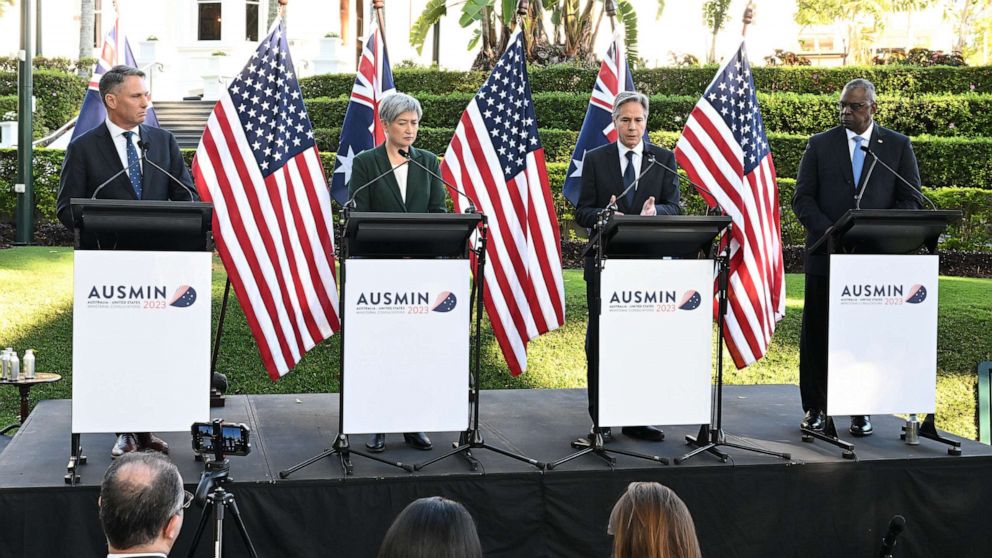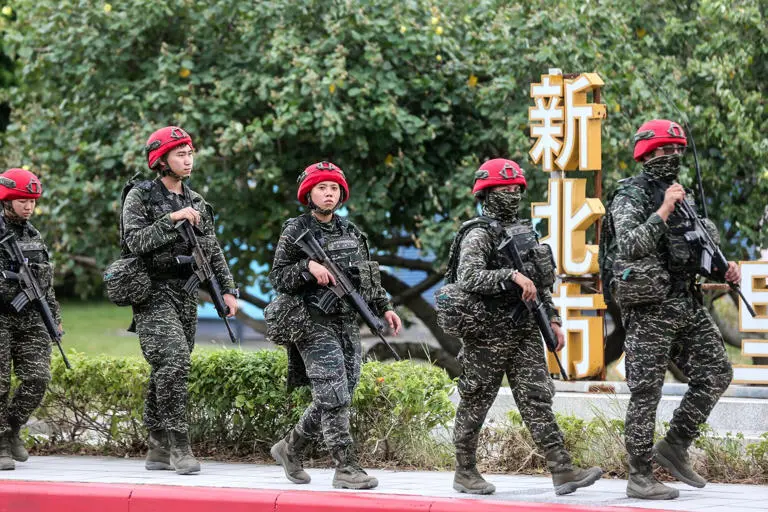The US has announced a historic $345 million military aid package for Taiwan, which for the first time will come from existing US military stockpiles instead of purchases through the foreign military sales program, the White House announced on Friday.
The announcement is a lesson learned from the US military assistance to Ukraine, where US-made weapons are quickly getting to the battleground, but it will also likely rile China, which considers Taiwan to be a breakaway province.
The Pentagon has signaled for much of the year that it intended to prepare such a passage after Congress authorized $1 billion for military aid to be provided to Taiwan under what is known as a Presidential Drawdown Authority (PDA).
The $345 million aid package was announced by the White House in a brief statement issued late Friday afternoon.
“By the authority vested in me as President by the Constitution and the laws of the United States of America, including section 621 of the Foreign Assistance Act of 1961 (FAA), I hereby delegate to the Secretary of State the authority under section 506 (a) (3) of the FAA to direct the drawdown of up to $345 million in defense articles and services of the Department of Defense, and military education and training, to provide assistance to Taiwan,” said the statement.
The statement did not include any details about what systems would be included in the historic announcement other than describing them as “defense articles and services.”
However, according to US officials, the aid package includes portable air defense systems, intelligence and surveillance capabilities, firearms and missiles.
Table of Contents
Why is this military aid package for Taiwan significant?

The aid package is significant for several reasons. First, it shows that the US is committed to supporting Taiwan’s security and sovereignty, as well as maintaining peace and stability across the Taiwan Strait. The US has a longstanding one China policy, which is guided by the Taiwan Relations Act, the three US-China Joint Communiques, and the Six Assurances. The US opposes any unilateral changes to the status quo from either side; does not support Taiwan independence; and expects cross-Strait differences to be resolved by peaceful means. The US also has an abiding interest in resisting any resort to force or other forms of coercion that would jeopardize the security, or the social or economic system, of Taiwan.
Second, it demonstrates that the US is willing to use its own resources and capabilities to provide timely and effective assistance to Taiwan. The Presidential Drawdown Authority allows the President to transfer defense articles and services from existing US stockpiles to foreign countries without congressional approval. This means that Taiwan can receive the weapons faster than through the normal foreign military sales process, which can take years. The PDA also reduces the cost for Taiwan, as it does not have to pay for new production or delivery. The PDA has been used before for other countries, such as Ukraine, but this is the first time it has been used for Taiwan.
Third, it enhances Taiwan’s asymmetric defense capabilities and deterrence against China. Taiwan faces a growing military threat from China, which has been conducting frequent and provocative air and naval activities near Taiwan’s airspace and waters. China has also been modernizing its armed forces and developing advanced weapons systems, such as hypersonic missiles and stealth fighters. Taiwan needs to improve its own defense capabilities to counter China’s advantages in quantity and quality. The aid package will help Taiwan acquire more mobile, survivable, and lethal weapons that can target China’s vulnerabilities and raise the cost of invasion or coercion.
How will China react?
China has not yet officially responded to the announcement of the aid package, but it is expected to strongly condemn it and take countermeasures. China sees self-ruled Taiwan as part of its territory and has vowed to bring it under Beijing’s rule, by force if necessary. China’s President Xi Jinping has said “reunification” with Taiwan “must be fulfilled” – and has not ruled out the possible use of force to achieve this.
China has repeatedly warned the US not to interfere in its internal affairs and not to send wrong signals to Taiwan’s independence forces. China has also imposed sanctions on US companies involved in previous arms sales to Taiwan. China may escalate its diplomatic pressure on other countries not to recognize or support Taiwan, or increase its military activities near or around Taiwan.
However, some analysts argue that China is unlikely to resort to drastic actions that could trigger a war or a crisis with the US. China may calculate that it still needs time and space to prepare for a possible conflict over Taiwan, and that it does not want to risk damaging its economic interests or international reputation. China may also recognize that the US is determined to uphold its commitments and interests in Taiwan and that any attempt to change the status quo by force would be met with a strong response.
What are the implications for US-Taiwan relations?

The aid package is likely to boost US-Taiwan relations and cooperation in various fields. The US and Taiwan share similar values, deep commercial and economic links, and strong people-to-people ties, which form the bedrock of our friendship and serve as the impetus for expanding US engagement with Taiwan. Through the American Institute in Taiwan (AIT), a non-governmental organization mandated by the Taiwan Relations Act to carry out the US’s unofficial relations with Taiwan, our cooperation with Taiwan continues to grow.
Taiwan has become an important US partner in trade and investment, health, semiconductor and other critical supply chains, investment screening, science and technology, education, and advancing democratic values. The US and Taiwan, under the auspices of AIT and the Taipei Economic and Cultural Representative Office in the United States (TECRO), have held the Economic Prosperity Partnership Dialogue to enhance economic and commercial ties, including supply chain security and resiliency, investment screening, health, science and technology, and the digital economy.
The aid package will also strengthen the security and defense partnership between the US and Taiwan. The US has been providing Taiwan with arms of a defensive character since 1979, as required by the Taiwan Relations Act. The US has approved nearly $19 billion in military sales of F-16s and other major weapons systems to Taiwan since 2016. The aid package will complement these sales and provide Taiwan with more immediate and effective assistance. The US and Taiwan have also been conducting joint military exercises, training, and exchanges to enhance interoperability and readiness.
The aid package will also reaffirm the US’s support for Taiwan’s international participation and dignity. The US has been advocating for Taiwan’s meaningful participation in international organizations, such as the World Health Organization, where Taiwan can make valuable contributions. The US has also been encouraging other countries to establish or expand their relations with Taiwan, especially in the Indo-Pacific region. The US has also been opposing China’s attempts to isolate or intimidate Taiwan diplomatically or economically.
FAQs for this military aid package for Taiwan
Here are some most asked questions:
What is the Presidential Drawdown Authority (PDA) and how does it work?
The PDA is a legal authority that allows the President to transfer defense articles and services from existing US stockpiles to foreign countries without congressional approval. The PDA is intended to provide timely and effective assistance to countries facing urgent security needs or humanitarian crises. The PDA has been used before for other countries, such as Ukraine, but this is the first time it has been used for Taiwan.
What are the main weapons systems included in the aid package for Taiwan?
According to US officials, the aid package includes portable air defense systems, intelligence and surveillance capabilities, firearms and missiles. These weapons systems are designed to enhance Taiwan’s asymmetric defense capabilities and deterrence against China. They are also more mobile, survivable, and lethal than some of the older systems that Taiwan currently has.
How will this aid package affect the US-China relations and the cross-Strait situation?
The aid package will likely anger China, which sees Taiwan as part of its territory and opposes any US interference in its internal affairs. China may condemn the aid package and take countermeasures, such as imposing sanctions on US companies involved in the deal, increasing its military pressure on Taiwan, or reducing its cooperation with the US on other issues. However, China may also avoid taking drastic actions that could trigger a war or a crisis with the US.
The aid package will also reassure Taiwan, which faces a growing military threat from China, that the US is committed to supporting its security and sovereignty. The aid package will also reaffirm the US’s one China policy, which is guided by the Taiwan Relations Act, the three US-China Joint Communiques, and the Six Assurances. The US opposes any unilateral changes to the status quo from either side; does not support Taiwan independence; and expects cross-Strait differences to be resolved by peaceful means. The US also has an abiding interest in resisting any resort to force or other forms of coercion that would jeopardize the security, or the social or economic system, of Taiwan.
Conclusion
The US’s announcement of a $345 million military aid package for Taiwan from its own stockpiles is a historic and significant move that will bolster Taiwan’s defense capabilities, deter China’s aggression, and enhance US-Taiwan relations. The aid package reflects the US’s commitment to supporting Taiwan’s security and sovereignty, as well as maintaining peace and stability across the Taiwan Strait. The aid package also demonstrates the US’s willingness to use its own resources and capabilities to provide timely and effective assistance to Taiwan.
The aid package will help Taiwan acquire more mobile, survivable, and lethal weapons that can target China’s vulnerabilities and raise the cost of invasion or coercion. The aid package will also boost US-Taiwan cooperation in various fields, such as trade, investment, health, science and technology, education, and democracy. The aid package will also reaffirm the US’s support for Taiwan’s international participation and dignity.
If you find this article helpful, share this with your friends, family and others. Don’t forget to visit our blog “USA Trend” to get more trending news.
